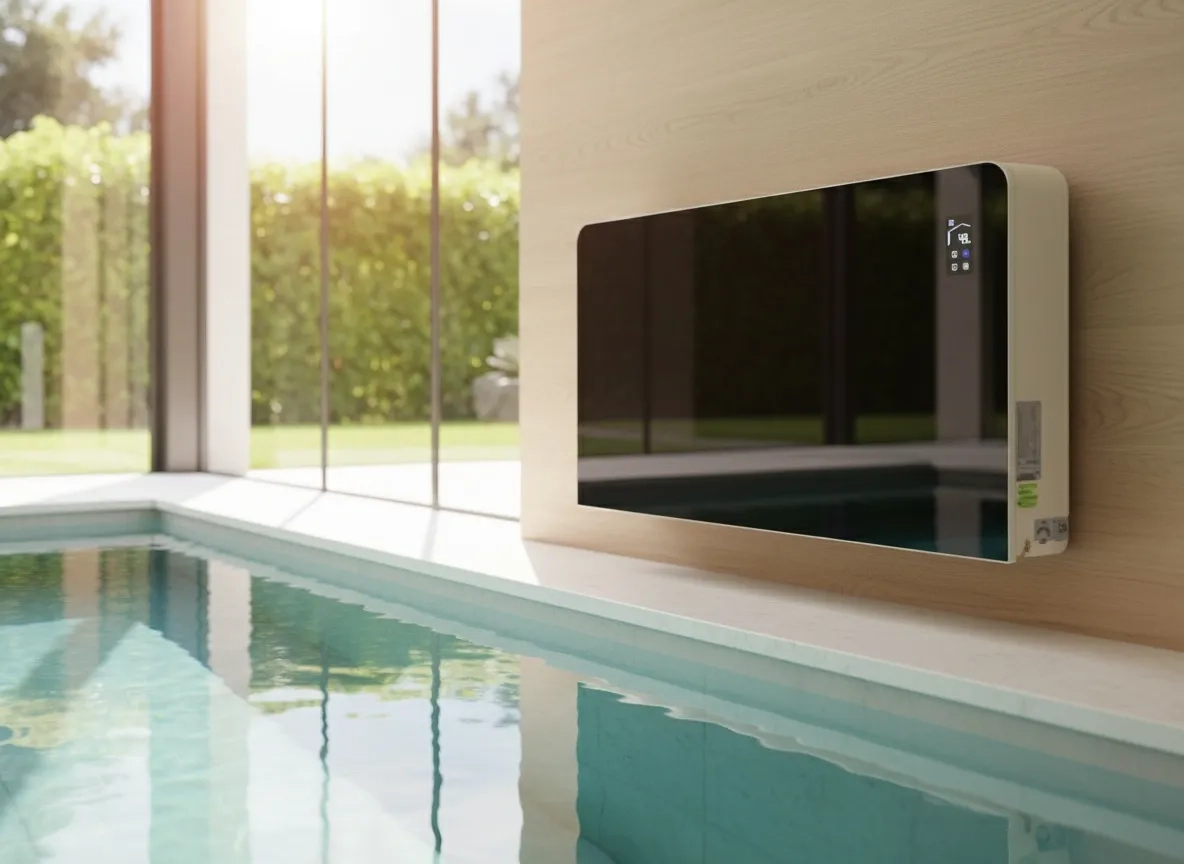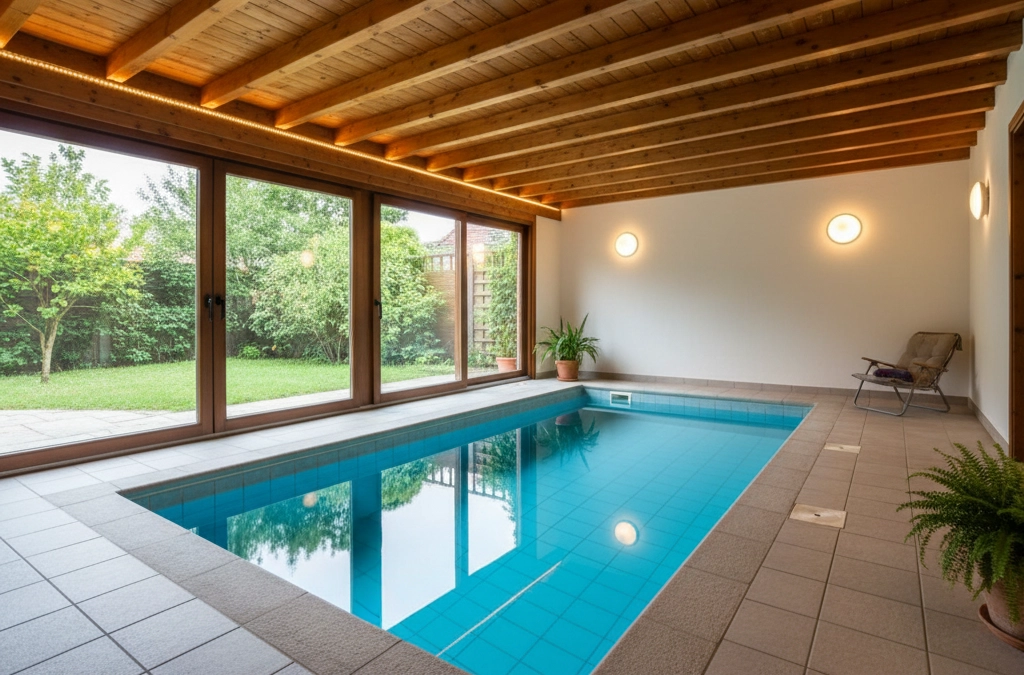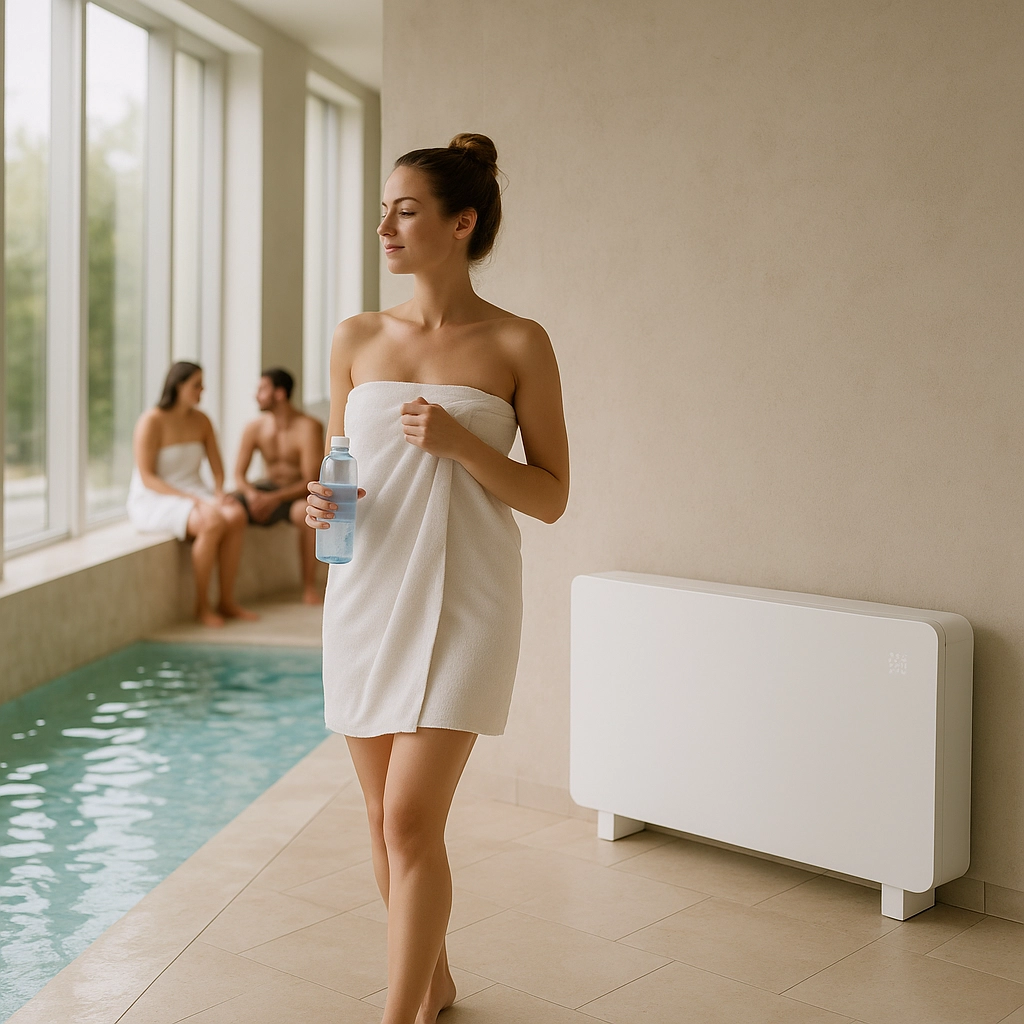
Did you buy a pool dehumidifier expecting condensation and humidity issues to disappear within a few hours? But after a day or two, the result isn’t as impressive as the ads promised? This scenario is familiar to many private pool owners who face disappointment after high expectations.
Marketing materials often present dehumidifiers as magical devices that instantly solve all humidity problems. The reality is more nuanced: dehumidifiers are indeed effective, but they have their limitations and operational specifics that you need to understand.
In this article, we’ll honestly explain what a pool dehumidifier can and cannot do, so you have realistic expectations and understand the actual timelines to see results. A dehumidifier is a tool with specific functions, not a magic wand.

What a pool dehumidifier CAN do
Does a dehumidifier remove humidity
Does a dehumidifier remove humidity? Absolutely yes, and this is its primary function. Professional MBA-G series dehumidifiers can remove from 53 to 108 liters of moisture per day depending on the model:
- MBA05G — 53 liters per day
- MBA07G — 84 liters per day
- MBA10G — 108 liters per day
These devices can reduce humidity levels from a critical 80–90% to a comfortable 50–60% and automatically maintain the set level. For pools, the recommended relative humidity is typically 55–65%, which is a balance between comfort and preventing mold growth.
Does a dehumidifier prevent condensation
Does a dehumidifier prevent condensation? Yes, but it’s important to understand how. When humidity drops to 50–60%, new condensation simply won’t form on surfaces. Important: existing condensation droplets must be wiped off manually; the dehumidifier won’t “evaporate” them. But after 24–48 hours of continuous operation, no new condensation should appear.
Additionally, maintaining humidity below 65% prevents the development of new mold, as spores cannot thrive in such an environment. This is important to understand: a dehumidifier provides prevention, not treatment.
Does a dehumidifier pull moisture from walls
Does a dehumidifier pull moisture from walls? Both yes and no — a dehumidifier directly removes moisture from the AIR, not directly from walls or other materials. The physics is as follows: a wet wall evaporates water into the air, and the dehumidifier removes that moisture from the air. This is an indirect process that occurs through natural evaporation.
However, there’s good news: the lower the air humidity, the faster damp surfaces dry. So a dehumidifier does accelerate the drying of walls and other materials by creating conditions favorable for evaporation.
A dehumidifier also significantly speeds up drying after flooding. While it does not dry walls instantly, it creates conditions where instead of 2–3 weeks of natural drying, the process takes 5–10 days depending on the amount of water and other factors.

What a pool dehumidifier CANNOT do
Does a dehumidifier eliminate mold
Does a dehumidifier eliminate mold? The answer is unequivocal — no. A dehumidifier stops mold growth by creating an unfavorable environment, but it does not kill existing spores or remove established mold colonies. One of the most common mistakes is to turn on a dehumidifier and expect the mold to disappear.
Existing mold must be removed mechanically using a brush and specialized antifungal agents. Only after this cleaning will the dehumidifier help prevent new mold by keeping humidity below the critical 65% level.
A dehumidifier also cannot draw moisture from deep within building structures. It only works with moisture contained in the air or on material surfaces. If a wall is soaked through, moisture will evaporate very slowly. Deep drying often requires additional methods — for example, heat guns together with a dehumidifier.
Realistic timelines: surface moisture may disappear in 2–3 days, deep moisture in 1–2 weeks of dehumidifier operation.
It’s important to understand that a dehumidifier does not replace ventilation. It reduces humidity but does not supply fresh air. Pools require ventilation to remove carbon dioxide, chlorine vapors, and other substances. The right combo is dehumidifier plus ventilation; one without the other is ineffective.
A dehumidifier also doesn’t work instantly — it takes time to reduce humidity, typically 24–48 hours. It’s not an air conditioner with a near-instant cooling effect. The drying process is gradual, albeit steady.
Finally, a dehumidifier won’t help if the root cause of excessive moisture isn’t eliminated. If your roof leaks, the walls lack waterproofing, or the pool is constantly left uncovered, even the most powerful dehumidifier won’t cope. First eliminate the source of moisture, then apply dehumidification.
Realistic timelines for results
Many pool owners get disappointed when quick results don’t appear. Here are realistic timelines for solving different humidity issues:
| Issue | What the dehumidifier does | Realistic timeframe |
|---|---|---|
| Humidity 80% to 60% | Lowers it by removing moisture | 24–48 hours |
| Condensation on windows | Prevents new condensation (wipe off the old) | 2–3 days |
| Foggy mirrors | Same as windows | 2–3 days |
| Fresh mold (under 1 month) | Stops growth but does not remove it | 3–5 days + mechanical cleaning |
| Old mold (over 3 months) | Stops growth | Professional cleaning required |
| Wet walls (surface) | Speeds up evaporation | 3–7 days |
| Soaked walls (deep) | Speeds up but slowly | 1–2 weeks |
| Room flooding | Speeds up drying | 7–14 days |
It’s important to understand that these timelines depend on several factors: dehumidifier capacity (MBA-G from 53 to 108 liters per day), room size, extent of damage, and air temperature. The warmer the room, the more efficiently the dehumidifier works.
How to use a dehumidifier correctly for maximum efficiency
To get maximum efficiency from your dehumidifier, follow these guidelines:
1. Eliminate the source of moisture first
Check for leaks, ensure proper waterproofing of the room, and cover the pool when not in use. Without addressing the root cause, fighting humidity becomes a never-ending process.
2. Give the dehumidifier time
Don’t turn the unit off after 2 hours if you don’t see an immediate effect. You need at least 24–48 hours of continuous operation. MBA-G can run 24/7 thanks to the low noise level (44–46 dBA), comparable to a quiet conversation.
3. Remove existing mold mechanically A dehumidifier won’t replace a brush and specialized products. Clean surfaces of mold first, then use the dehumidifier for prevention.
4. Set the correct humidity level For pools, the optimal range is 50–60%. Don’t go below 40% (it can cause excessive dryness and discomfort) and don’t allow it above 65% (risk of mold growth). MBA-G allows you to set working relative humidity from 40% to 90% RH.
5. Ensure air circulation Wall mounting is best done about 30 cm from the floor, as humid air is heavier and concentrates lower, near the water surface. Avoid placing it in dead corners — there should be free space on the sides for natural circulation.
Do not block the front panel where the air intakes are located. Do not place furniture, cabinets, or decor directly in front of the dehumidifier — minimum distance 50 cm.
6. Service the unit regularly Clean the filters every 2–4 weeks, check the drainage system (the condensate pipe diameter of 7 mm must have a slope), and perform annual maintenance with a specialist.

MBA-G as an example of an effective dehumidifier
The MBA-G series from Mycond demonstrates what a professional pool dehumidifier should look like. Here are the key specifications of the different models:
| Model | Dehumidification per day (liters) | Airflow (m³/h) | Noise (dBA) | Power consumption (kW) | Operating temperature (°C) |
|---|---|---|---|---|---|
| MBA05G | 53 | 450 | 44 | 0.89 | from 10 to 32 |
| MBA07G | 84 | 600 | 44 | 1.09 | from 10 to 32 |
| MBA10G | 108 | 750 | 46 | 1.95 | from 10 to 32 |
Choosing a model depends on the pool area:
- MBA05G — up to 22 m²
- MBA07G — from 22 to 35 m²
- MBA10G — from 35 to 50 m²
MBA-G features that make it effective:
Continuous operation: Thanks to quiet operation and automatic humidity control, the unit can run 24/7 without the need for constant monitoring.
Corrosion protection: The golden epoxy coating of the heat exchanger provides protection against an aggressive environment (humidity + chlorine). Unlike ordinary dehumidifiers, MBA-G does not rust for years. Additionally, the device uses the eco-friendly refrigerant R32.
Wall-mounted installation: Doesn’t take up floor space, ensures proper air circulation, and allows easy access for maintenance. Dimensions: MBA05G — 1343×248×790 mm, MBA07G — 1543×248×790 mm, MBA10G — 1743×248×790 mm.
Frequently asked questions about pool dehumidifiers
How long will it take for the dehumidifier to remove condensation from windows?
A dehumidifier doesn’t remove existing condensation — you need to wipe it off. But after 24–48 hours of operation, no new condensation will appear if you maintain humidity at 50–60%.
Does a dehumidifier eliminate mold?
A dehumidifier will stop mold growth but won’t remove what’s already there. First, remove mold mechanically with specialized products, then the dehumidifier will prevent new mold if humidity stays below 65%.
Does a dehumidifier pull moisture from walls?
Yes, but not directly. A dehumidifier lowers air humidity, causing moisture from walls to evaporate faster. Surface moisture will disappear in 3–7 days, deep moisture in 1–2 weeks.
Is ventilation needed if there’s a dehumidifier?
Yes, absolutely. A dehumidifier reduces humidity, but it doesn’t supply fresh air. A pool needs ventilation to remove CO₂ and chlorine vapors.

Why won’t humidity drop below 70%?
Possible reasons: insufficient dehumidifier capacity, a continuous source of moisture (a leak), a room that’s too large for your model, improper installation, or blocked air circulation.
Can I leave the dehumidifier on overnight?
Yes, the MBA-G operates quietly (44–46 dBA) and can run around the clock. Moreover, to achieve maximum efficiency, continuous 24/7 operation with automatic humidity maintenance is recommended.
Does a dehumidifier remove large amounts of moisture?
For a pool, removing 50–100+ liters per day is normal. From each square meter of water surface, 4–5 liters of water evaporate daily. That means a 30 m² pool releases about 120–150 liters of water into the air. MBA-G removes from 53 to 108 liters depending on the model.
When won’t a dehumidifier help?
If there is a constant source of moisture: a leaking roof, groundwater without waterproofing, an uncovered pool. First remove the cause of excess humidity.
Conclusion
A pool dehumidifier is an effective tool, but not a magic wand. The key to success is realistic expectations and proper use.
Mycond’s MBA-G is a professional solution for pools with real performance from 53 to 108 liters per day. Three models for different areas, quiet operation (44–46 dBA), the ability to run 24/7, a golden epoxy coating for corrosion protection, eco-friendly refrigerant R32, and wall mounting to save space.
Mycond is a leader in its segment for those seeking a comprehensive, modern, and energy-efficient microclimate solution without overpaying for a global brand name. Premium-class technologies at a fair price, with reliability and efficiency proven over years in the harsh environment of pools.
Need a free consultation to select an MBA05G, MBA07G, or MBA10G model based on your pool area and specific needs? Our specialists will help you understand whether a dehumidifier suits your specific situation, what results timeline to expect, and how to use it correctly.
Contact us by phone or fill out the form at the bottom of the page — our specialists will help you choose the optimal model and answer all your questions.